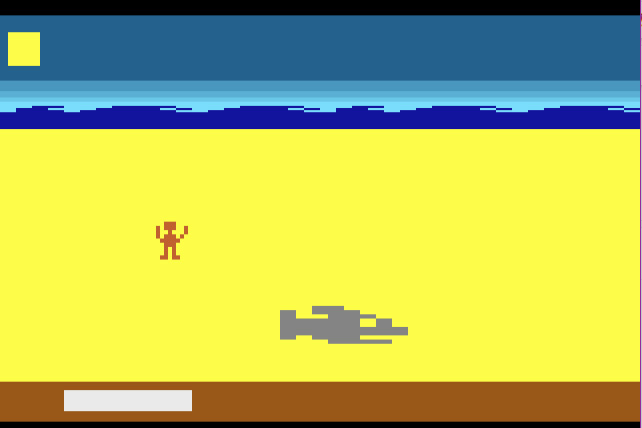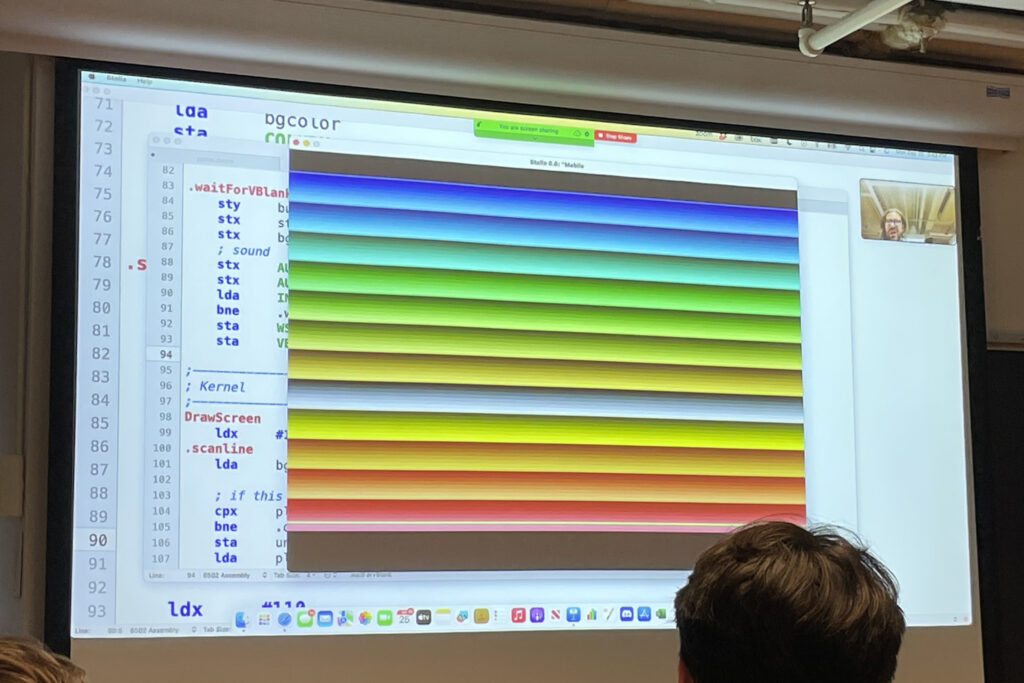
Welcome to the future.
The year is 2016. Birds have been extinct since the Reagan administration. Auto-avian robots war with humanity amidst the rubble of once-great cities.
In Battle Bird-Bot Blowout, Peri Glick, a senior majoring in film and media studies in Arts & Sciences at Washington University in St. Louis, deploys vintage 128-color NTSC graphics and a nearly 50-year-old programming language to craft a new game for the iconic Atari 2600 console.

Unlike contemporary games, “in the Atari, you don’t get to program a lot of plot,” Glick says with a wry grin. “Typically, games would come with a pamphlet. So in my pamphlet, I describe a dystopian future. Robo-fowls are now spies. If you spot one, you need to shoot it out of the sky.”
Glick created Battle Bird-Bot Blowout last fall as her final project in the course “Retro Game Design.” Taught by Ian Bogost, the Barbara and David Thomas Distinguished Professor and director of film and media studies, the class explores the history, aesthetics and idiosyncratic technology of the Atari, which dominated — and in many ways invented — home videogaming in the early 1980s.
“Atari was eponymous,” Bogost says. “‘Do you have an Atari?’ ‘You want to play Atari on that Atari?’ For a while, video games were just Atari. Now you look back, all these kids in their wood-paneled basements, it seems almost fictional.
“But it happened.”

A very weird computer
“Today I’m going to show you how to make your own games from a starter template,” Bogost announces to about 60 undergraduates in Eads 016. His laptop is synced to a dozen monitors around the room. “If we have time, we’ll make a game before we depart.
“All of which involves me live coding,” Bogost deadpans, “in ways that make me anxious.”
Bogost, who also serves as professor of computer science and engineering in the McKelvey School of Engineering, doesn’t seem especially anxious. A celebrated game designer, he is co-author, with Nick Montfort, of Racing the Beam: The Atari Video Computer System (2009), one of the first books to explore how digital media platforms shape creative expression. A Slow Year (2010), Bogost’s collection of seasonally themed Atari game poems, is in the Smithsonian American Art Museum’s permanent collection.
“The Atari is a very weird computer,” Bogost observes a few days later. For example, “it has no video memory. Most computers let you build a screen’s worth of information at a time. The Atari makes you interface with every television scan line. I’ve never seen another computer that works like it.”
And yet, “once I started really paying attention to the machine, I found it delightful,” he adds. “At some point, my intellectual interest in the system became a creative interest in making stuff for it.”

Basic instructions
Back in Eads, Bogost gives a short refresher on zero-page memory; spends a few minutes distinguishing NTSC (National Television System Committee) from PAL (Phase Alternating Line) video standards; and summarizes how the influential 6502 microprocessor — which powered the Apple II, Commodore 64 and other early home computers — differed from Atari’s 6507 variant. (The latter “was cheaper.”)
Next, using the Stella emulator — a contemporary, open-source tool that runs Atari games and mimics the Atari Assembler environment — Bogost quickly runs through the mechanics of color selection, the importance of cleaning out registers between operations and some best practices for organizing Atari code.
“It’s really easy to lose your bearings, especially when code gets long,” Bogost says. He shows students how to use semicolons to create labels and insert editorial comments. “There are a lot of ways to write a computer program. This is not the only way. But over the years, I’ve found that structuring programs in this manner make them easier to read.”
Notably, though many students in “Retro Game Design” have computer science backgrounds — Glick, for example, was already pursuing a computer science minor — many do not.

“This was my first coding class,” says Kaitlyn Thornton, a junior studying biomedical engineering. Like Glick, she took the course in 2022 and now serves as a teaching assistant.
“It’s probably one of the best classroom experiences I’ve had,” says Thornton, who has since begun her own computer science minor. “Getting this very bare bones understanding — realizing that the machine is there to help you, and that it’s going to do exactly what you tell it — made learning more abstract languages easier.
“Plenty of courses have you build things, even games,” Thornton says. But her final project for “Retro Game Design” — Beached, about sharks desperately hunting for water — still feels uniquely personal. “It functions, it runs and it doesn’t rely on anything other than basic instructions.
“The Atari is weird and strange,” Thornton adds. “In some ways, it’s a terrible piece of technology. But it can make these fun, simple things that really aren’t simple at all — and make them beautiful.”

;————–
Poetry
;————–
“My own work for the Atari starts from the idea that the platform is still alive,” Bogost says. “It’s not dead. It not obsolete. It’s still alive in the same way that the sonnet is still alive, or the view camera is still alive.”
Despite the infamous video game crash of 1983 — which decimated Atari revenues and sparked a long series of selloffs, acquisitions and bankruptcies — the 2600 console still maintains a passionate fan base. The first “homebrewed” Stella emulator was released in 1996. (“Stella” refers to a pre-production codename for the Atari chipset.) A decade later, Bogost led a group working to improve its television-like effects.
“There’s a lot of hobbyist development,” Bogost says. The programming “is pretty easy to pick up. Anybody can do it, which is one reason I teach the class. There’s nothing between you and the hardware. You feel every bump.
“Working within those constraints, for me as a programmer, feels deeply calming.”

Indeed, in his 2016 book Play Anything, Bogost argues for the creative benefits of constraints and limitations. “This idea is very familiar to artists,” he says. “I think that’s one reason the Atari appeals to me — maybe one reason computing appealed to me. Rather than powerful machines that can do anything, they were inept machines that can’t do very much at all.”
Returning to Eads, Bogost shows students how to replace solid backgrounds with a rainbow-like series of horizontal rows. He then sets those rows in motion and adds a narrow, string-like band in a single, solid color. Finally, as the background scrolls by, he moves the band and tries to match it to the rainbow.
In other words, Bogost has just built a game — a game so simple and economic that, in just 120 bytes, it approaches poetry.
“In their heyday, most Atari games were written by a single person,” Bogost says. “Steve Cartwright, the original Activision developer, made games like Barnstorming and Frostbite, which are almost painterly. I’ve always been inspired by that. I think it contributes to that sense of quietness: you alone, giving instructions. It’s very methodical.
“If you can just listen to the machine and let it guide you,” Bogost says, “it will show you what’s possible. And once you see what’s possible, you can try to move beyond it.”



